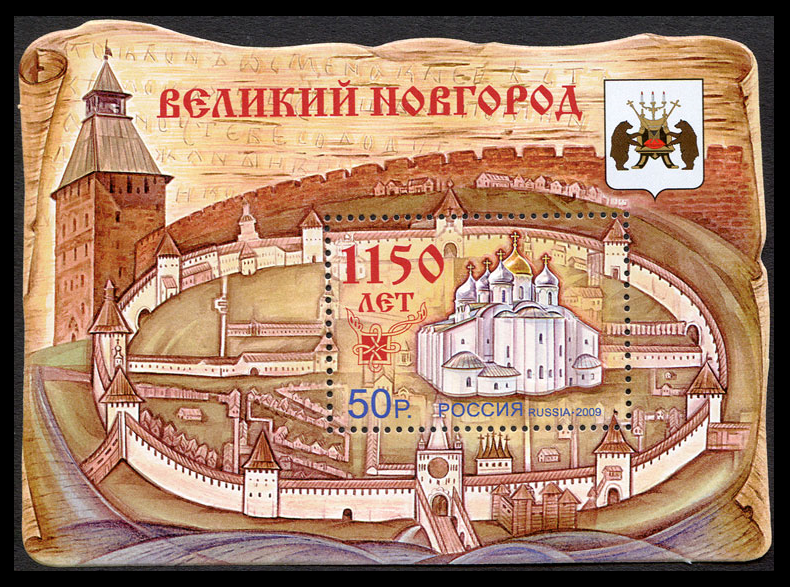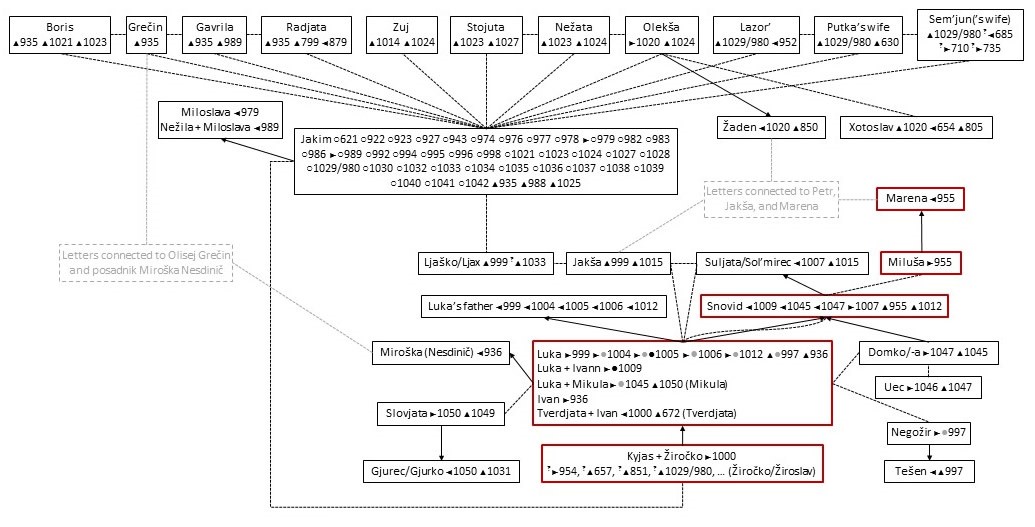How to communicate in Medieval Russia?
This blog post explores how everyday medieval life is reflected in the short messages that people wrote on pieces of birchbark in Novgorod between the 11th and 15th century.


“From Kyas and from Zhirochko to Tverdjata and to Ivan. We are both fine.” (N1000)
This witness from medieval times seems to contain nothing more than a greeting from two companions to two other men. It looks like a modern postcard sent from vacation, saying: ‘Having a wonderful time; wish you were here!’. However, it is much more than that. It is part of a most remarkable collection of medieval texts from the north-west of European Russia and comes from the old city of Novgorod, approximately two hundred kilometers south of St. Petersburg.
Here’s another example, which is a business letter. The senders, Luka and Ivan, evidently traded in foreign merchandise; the ‘Greek merchandise’ that they mention concerns imports from the Byzantine Empire or its colonies on the Black Sea, while the ‘overseas merchandise’ refers to products from North-Western Europe, presumably coming through the Baltic Sea:


“[From] Luka and from Ivan to Snovid. We are both fine. We’ve already sold (everything). We didn’t buy (any) Greek merchandise. Try to get a little overseas merchandise.” (N 1009)
A third example shows the variety of topics that are addressed in the collection. This text consists of three sections, each of which begins with an ornamental initial. It clearly contained a drawing, which is vaguely visible to the right: a cross with a woman and a man on either side. In relation to the text, it seems to be the depiction of a wedding ceremony, in which a certain Snovid seems to be groom:


[Upper part] “From Miluša to Marena. Big Braid, may she (or: let her) marry Snovid.”
[Lower left] “Marenka, let the vagina drink and the clitoris.”
[Lower right] “Thus spoke Miluša: Give yesterday’s 2 grivnas.” (N955)
Birchbark
What is so remarkable about these three examples? First and foremost, they are not written on parchment or paper but on pieces of birchbark. Birchbark is a soft material, and it is easy to scratch marks and letters on it with a sharp instrument. You can use it to write notes for yourself or a message to someone else. This was a common practice in Novgorod and other cities in the region during the Middle Ages, when paper was not yet widespread, and parchment too valuable for everyday use. In the course of archaeological excavations in medieval cities in northwestern European Russia, more than twelve hundred birchbarks with inscriptions have been found. Since 1951, almost every summer excavation season has brought new birchbark documents to light.

The average birchbark user
Writing and corresponding on birchbark was deeply integrated into a wide range of activities in medieval Novgorodian society. Birchbark letters were not the exclusive domain of the social elite and there is no evidence that professional scribes were employed on a large scale or, more generally, that the production of birchbarks was ever a professionalized domain (as book production was). In principle, anyone who was aware of the use of writing and had something important to convey could send one. The ‘average birchbark user’ was a member of the social elite – boyars and prominent merchants, people with money and power, as well as those who had to conduct business with them or for them. If the letters mention money, it is usually a large amount; if they mention social conflicts, there is usually a great deal at stake. But this is only the general picture; the birchbark letters provide such rich data on social life that we can give a much more nuanced account of the users. Many were indeed wealthy and powerful men who were prominent in the secular life of the city, but this was certainly not always the case. Some birchbarks were written by members of the clergy, the class that comprised the main users of parchment literacy; for instance, one monk, Efrem, writes to appease another, Isukhia, who is angry because Efrem failed to show up for an appointment. Other birchbarks were sent by villagers to gain the attention of their absent landlords; in a dramatic letter starving peasants tell their master that they have no seeds to plant and nothing to eat (‘We are ruined now, lord’).
Women on birchbark
Dozens of birchbark letters have women as their authors or their addressees. To give some examples: in the oldest known text by a Slavic woman, the author scolds her lover for neglecting her and threatens him with hell if he is toying with her affections; Nezhka berates her brother at considerable length for reneging on a promise; Anna pleads with her brother to help her in a legal wrangle because her opponent has accused her of fraud and slandered her honor (‘you called my sister a slut and her daughter a whore’); Nastasia writes in grief to tell her brothers that her husband has died and wonders how she and her children will get by in the future; and in one of the most famous birchbarks, Gostjata begs for help (‘Please come!’) because her husband has thrown her out of the house, married another woman, and kept her dowry for himself.
Hansa kontor Novgorod
The oldest known birchbark texts are dated to the early eleventh century, only one generation or so after the official Christianization of the East Slavic world (988) and the spread of Christian education. The youngest texts are from the late fifteenth century when the political and economic power of Novgorod waned and the Novgorodian lands were forcibly annexed by Grand Prince Ivan III of Muscovy. Within this timeframe, which covers almost five centuries, Novgorod rose to power and prosperity as a merchant city because of its ideal location on major river routes connecting the Baltic and the Black Sea and the Volga River with the Caspian Sea and the Silk Road. Byzantine and Asian luxury goods, such as silk, jewelry, wine, and glass, made their way through Novgorod to Scandinavia and Northern Europe, while Novgorod exported its own wax, honey, and especially fur, from the most precious sable to the cheapest squirrel skin. Especially German merchants of the Novgorodian office (kontor) of the Hanseatic League (Peterhof) played an important role in organizing the fur trade: they sorted the fur, bound it in bundles of forty pelts, and arranged its further shipment to Western Europe, especially Bruges. Many European merchants visited Novgorod every year, and the Novgorodians actively traded their goods for Western products, such as silver and other metals, linen, woven fabrics, amber, weapons and other wrought goods, salt, preserved fish, wine, and also grain.

Social networking
Let us return to the three examples cited above: these are labelled N1000 and N1009, both found in 2010, and N955, which was unearthed in 2005. They are all dated to the period 1140-1160 on the basis of stratigraphical and dendrochronological methods. One of the recipients of the first letter is Ivan, a name that also appears in the second letter, in which Ivan, along with Luka, informs Snovid about their long-distance business. We also encounter the unusual name Snovid in the third letter, in which the matchmaker Milusha writes to negotiate with the mother (Marena/Marenka) of a prospective bride (‘Big Braid’): ‘may she (or: let her) marry Snovid’. Are we dealing with two different Ivans and two different Snovids? No. They are both part of an extensive social network, which can be established on the basis of dozens of letters in which Ivan and Snovid occur on several occasions, as sender or recipient. The social network in which these people figure on birchbark looks as follows:

It is too complicated to explain the exact relationships between all these people in the diagram (the exact meanings of lines, arrows, and symbols in different colors). But if you take a closer look at the red text boxes in the lower section of the diagram, you see the names of Luka, Ivan, Snovid, as well as Milusha and Marena (N955) and Kyjas, Zhirochko, and Tverdjata (N1000). There is good reason to assume that Luka and Ivan were not only close business associates but also relatives, probably brothers. It has also been suggested that their father may have been Snovid. Within this network, a most interesting letter is N936, in which Ivan mentions Luka. The fragmentary letter is addressed to a certain Miroshka Nesdinich, a prominent boyar, who served as posadnik (mayor) of Novgorod from 1189 to 1204. Miroshka is one of the few Novgorodians who made it into western historical sources, namely the oldest Hanseatic treaty (1191-1192) between Novgorod, Gotland and the German cities. Here Miroshka is mentioned as posadnik (mayor) of Novgorod; according to Old Russian chronicles he served from 1189 to 1204.
In general, interpreting birchbark texts is a precarious business. Occam’s razor should always be in reach. The combination of possible archaeological complications, ambiguous historical evidence, and linguistic problems is a challenge in itself. On top of that, we have to deal with patterns of written communication that are totally unfamiliar to modern readers, who are used to a clear distinction between how to ‘frame’ a message when they speak and when they write.
Further reading:
Jos Schaeken, Voices on birchbark. Everyday communication in Medieval Russia. Leiden: Brill, 2019.
The full corpus is available at http://gramoty.ru/birchbark/.
© Jos Schaeken and Leiden Medievalists Blog, 2019. Unauthorised use and/or duplication of this material without express and written permission from this site’s author and/or owner is strictly prohibited. Excerpts and links may be used, provided that full and clear credit is given to Jos Schaeken and Leiden Medievalists Blog with appropriate and specific direction to the original content.


